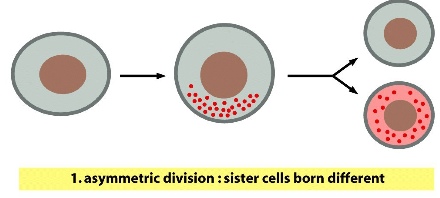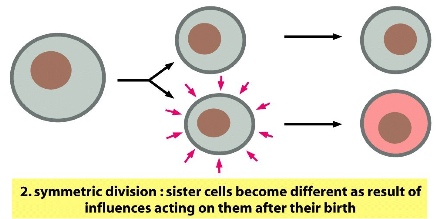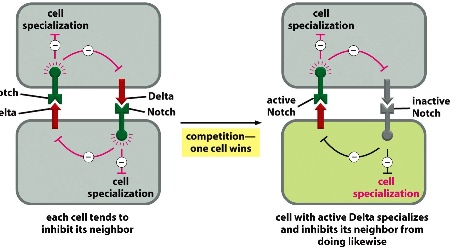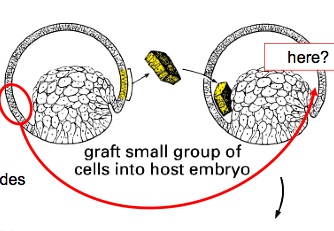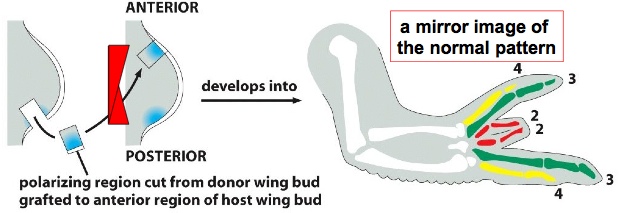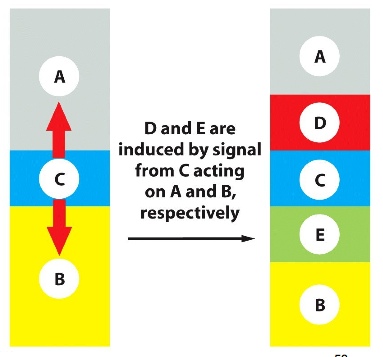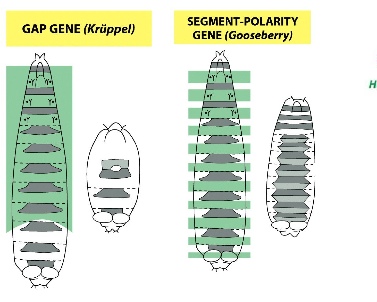2 main mechanisms of cell differentiation:
First one is
intrinsic difference —> daughter cells receive different factors so they are born different. (they divide
asymmetrically from the beginning)
> partitions cell fate determinants(factors that are only found in one of the daughter cell) to define germ line and other tissues ???
> requires cortical polarity and proper spindle alignment(the spindles need to separate the 2 daughter cells at the right place so that only one of the cells have those factors and not both)
> e.g. c.elegans:
Second one is extrinsic difference: born the same, but one becomes different from another due to later influences (divide symmetrically).
Mechanism for extrinsic cell differentiation:
1) Direct lateral inhibition (cells directly affect one another):
<1> at the beginning, the level of differentiation is similar across all cells, and all cells experience similar inhibition
<2> gradually, some cells randomly gain advantage, and become more differentiated than others. These cells will inhibit other cells around them more strongly.
<3> finally, these cells will inhibit the differentiation of all neighbouring cells and become differentiated —> pattern of isolated differentiated cells
How is this achieved? A: Notch signalling
Notch receptors and Delta (ligand) are both transmembrane proteins.
In the beginning, the Notch-Delta complex compete with one another trying to shut the other complex down. Gradually one cell gains advantage and 1) shuts down the specialization of its competitor and 2) prevents its competitor from inhibiting back.
This is shown in the study of Dropsophila bristles. Normally these bristles would be evenly spaced out, but when Notch signalling are not working, you can see patches of bristles very close to one another because there’s no inhibition.
2) Induction by diffusible signals
- cells begin with equal potential to become differentiated
- a diffusible signal from neighbouring cells drive groups of cells into distinct developmental pathways (????)
- signal is limited in time duration and distance (close cells experience strong signals and faraway cells experience weak ones) —> morphogen molecules create a gradient that centre around the signal source: different concentration of the same morphogen can trigger different effects on cells along the gradient
Organizer tissues act as morphogen sources: discovered through transplant experiment.
When the tissues signalling the making of dorsal part are transplanted from one embryo to another, the resulting embryo has two dorsal sides. But if we transplant the tissues from the opposite side, nothing happens, which suggests that there is only ONE ORGANIZER that decides the dorsal side —> ventral side is made by the absence of dorsal organizer.
In vertebrate (i.e. the wing development of chicks), there is a gradient from the source of the morphogen protein Shh (sonic hedgehog) which controls the formation of digits.
red triangle is the gradient indicator
A transplant experiment is done, and it turns out that Shh indeed controls the formation of digits (highest concentration —> digit #4, and lowest concentration —> digit #2). Isolation and transplant of Shh containing beads have the same power.
3. Regulatory hierarchies
the formation of hierarchy or zones is triggered by different signalling environment depending on the previous zones —> extended segmental pattern
Segmental pattern is regulated by transcription factors —> activate certain genes —> presence and absence of proteins create segmentation
e.g. Kruppel transcription factor decides on the development of the middle segment. Gooseberry decides on every other segment.
Homeotic selector (Hox) genes (a group of genes???) decides which body parts come from which segment.
e.g. experiment of Drosophila shows that misimpression of the gene leads to disposition of body parts.
Important points:
- order of the segment/body parts is the same as the order of the corresponding genes on the chromosome
- this pattern is highly conserved across species —> humans and Drosophila have similar pattern of gene location (Hox gene clusters) and segment location
- although similar, Hox genes encode transcription factors that have different targets in different organisms —> so that the downstream protein production is different (in flies they may make wings, in humans they do not). Same transcription factors may target different genes on the downstream level to have different results.
